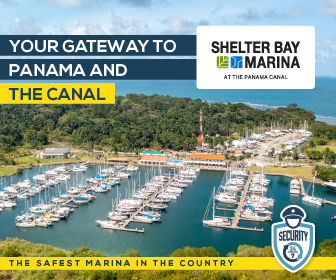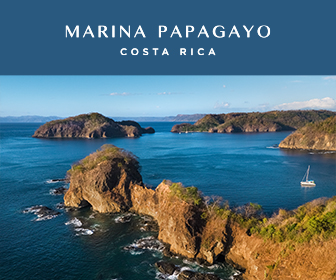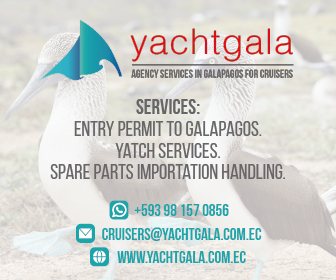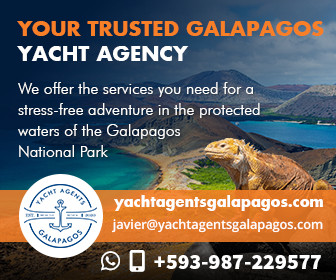Transiting the Panama Canal 2012/13: Cruisers Report
These reports are by boats that transited the Panama Canal late 2012 to 2013. See links at the bottom to previous reports from cruisers who transited Spring 2012.
Published 11 years ago, updated 5 years ago
A report posted 30th March 2013
From Susan Bright of SY Yindee Plus
After what seemed like weeks of reading about it, planning for it and low-level anxiety about it we finally came to our transit day on Sunday 7th April 2013. We left Shelter Bay Marina at 1 pm and arrived at Panama City at 2.30 pm on Monday 8th having passed from the Caribbean Sea through 3 locks, a 30-mile long lake, under a huge cable-stayed bridge, through 3 more locks and then into the Pacific Ocean. Here’s how it all happened from start to finish…
March and April are the busiest time of year for yacht transits as boats coming from the Pacific side to the Caribbean want to have time to get north before the start of the hurricane season in June. Most boats going the other way are about to head off across the Pacific Ocean and need to delay their arrival in French Polynesia until early May when the South Pacific cyclone season ends.
It is possible to transit the canal without a local agent (friends of our’s made the arrangements without speaking any Spanish) but it is generally quicker and much less hassle to do it via one if you are able to afford the fee (about $350). We chose to do that as we wanted to minimize the stress involved and avoid delays which we might unintentionally cause and which incur a fine from the canal authorities. The best agents in 2013 seemed to be Erick Centenario and Roy Bravo. We contacted Erick a few days before we arrived in Panama. He replied without delay, asking for details of the boat and then he started the administration process.
The first step is Admeasurer’s visit. He is employed by the canal to measure your boat and take down information about your maximum speed, fuel capacity, engine details, and other things. He will come to the boat in Shelter Bay Marina (where we were) or at The Flats anchorage. Once the information is in the system your agent can get a transit date for you. When we arrived at Shelter Bay it was the middle of March and the wait time was only about 4 – 5 days. We needed time for Chris to go back to the UK so we asked for a later date which was no problem. By the time we left the marina though, boats were having to wait 12 days or more, with the daily berth charges stacking up.
About four days before the transit the fee has to be paid. Ours was around $1000 total (inspection, tolls and security fee). They only accept cash. We saw many cruisers frantically borrowing cash from other boats and going to the ATM every day to amass enough. If you have an agent then they collect the money from your boat. If not then you have to go to a bank in Colon and pay it.
At this stage, we had to arrange some line handlers. Each boat has to have four adults, besides the skipper, who are capable of tying a knot and following instructions. It’s possible to hire “professional’ line handlers, who are paid $100 each. They have been through the canal many times and know what to do with the lines but don’t necessarily understand how a small boat moves. Most boats chose to take other cruisers and just pay their travel expenses back (about $30 by bus and taxi). There doesn’t seem to be any shortage of people willing to do this as it’s the perfect way of preparing yourself for your own transit. Chris went as line handler to our friends on Chilli Cat and felt much more confident about the whole venture when he came back. The line handlers sleep on board your boat and are fed by you during the trip so it can be quite a sociable occasion as well. We were lucky that our friends on Tuatara had arrived in Shelter Bay just before the weekend so Alan was able to come with us. We also took the crew from Sirius. We were glad we’d not taken ‘professionals’ as the atmosphere was relaxed and fun.
The agent supplies four regulation length ropes and enough old car tires already wrapped in plastic for you to hang on the sides of the boat to protect it. These are to supplement your own fenders. The tires and ropes arrived at the boat the day before transit.
Two working days before our departure we had to clear out with the Port Captain. Panama, being a Latin American country, is heavily laden with bureaucracy and the processes involved in moving from one region to another involve copious numbers of photocopies of the boat and personal documents plus the inevitable fee ($35 on this occasion). Our agent advised us to avoid the immigration authorities altogether….a contentious visa fee of $105 per person had recently been scrapped by the government but the authorities at Shelter Bay insisted on still collecting it! That’s the reason we cleared into the country further up the coast at Portobelo: a stamp in our passport there enabled us to avoid immigration elsewhere. So we cleared out of the country in Shelter Bay as our agent advised us but stayed at the anchorage in La Playita on the Pacific side for another couple of weeks. We weren’t sure that it was entirely legal but trusted the agent to suggest the best course of action!
We didn’t have to make many preparations for the boat for the canal. We removed the nets that are attached to the guardrails (most kid boats have these for extra safety) so that we could pass the canal lines from the cleat directly to the wall. Otherwise, they would have had to be led through a fairlead which is only screwed, not bolted, into the deck and wouldn’t have been strong enough for the potential tension. We also moved our outboard motor from it’s a normal location on the side of the boat and put it on the back. We had already planned a menu and bought the food.
At 1 pm on the big day, we paid our marina bill, said goodbye to the many friends we’d made at Shelter Bay, and motored our fendered Yindee Plus and crew off to The Flats anchorage near the entrance to the canal to wait for our Trip Advisor to arrive by pilot boat. The transit involved two Advisors; one for each leg of the trip. We knew via our agent that he would be coming at about 6 pm. All small yachts going to the Pacific follow a similar schedule: leave The Flats early evening, pass through the floodlit first set of locks and then moor to a ships’ buoy in Lake Gatun for the rest of the night; then start again at about 6 am to complete the transit by the afternoon. We can’t do it in one day because our boat speed isn’t fast enough.
As soon as the Advisor was on board, we pulled up the anchor and we were off. We used the half hour before the canal to prepare our lines. Each one had to have a large loop, in the end, coming from the cleat and be flaked out ready to run free.
There were five yachts transiting at the same time as us. Three boats of similar size were rafted together. We were on the right-hand side of that raft. The other raft was a smaller Canadian boat and a catamaran. The raft was created just before the entrance to the lock and needed lots of fendering between the boats. Initially, our bow was tied too tightly and we weren’t lined up straight with the other two boats. Chris found it very hard to steer as the boat wanted to go to port. Our advisor didn’t want to adjust it at that point though.
The first three pairs of locks at Gatun lift the boats a total of 27 meters, to the level of Gatun Lake (the largest artificial lake in the world). The energy used for the lock gates and other equipment is hydroelectric but there are no pumps: water enters the chamber from holes in the bottom by gravity alone. The whole construction project and operation is incredible and well worth reading about and there’s a visitor’s centre which is excellent. The canal is one hundred years old in 2014 and the authorities had hoped to celebrate it by completing a current widening programme. New sets of locks are being built that will eventually complement the existing ones and will allow even larger ships to pass through. At the moment, ships that need to pass between the oceans are built to the maximum size possible to fit in the locks (Panamax ships). We’ve seen the building site for the new locks at Gatun and it is very impressive, but it’s behind schedule by about a year. The original canal was opened six months ahead of it’s planned a date in 1914 but to little acclaim, as World War one had broken out only a few days before and was dominating the news!
Between the entrances to the east and west locks is a long pier. Our raft of boats moved towards the pier so that the shoreside line handlers could throw two ropes down to the nearest boat. The ropes are weighted with a “monkey’s fist’. The men aim for the foredeck to avoid smashing windows or solar panels but accidents can happen. We had put our cockpit cushions over our coach roof glass to protect it. Once the monkey’s fists are on the deck the yacht line handlers on the left of the raft grabbed them and tied them to the boat ropes, one at the bow and one at the stern. The raft continued moving towards the lock and, at the entrance, the raft moved to the right so that our line handlers could catch the monkeys fists from the other side. Unfortunately, both fists wrapped themselves around the rigging and it took a little longer to get them into position. Meanwhile, the raft had slowed down and we were caught by an eddy which dragged the whole raft into the lock wall. We gasped as our stern quarter made contact with the wall and we dragged along it. Lucky for us we had fendered well and removed our side attachments (an outboard motor would have been trashed). The contact was only with the fenders and our boat was not damaged.
Once inside the first lock, the wall line handlers pulled in our boat lines and attached the loop over bollards. The whole raft of three boats was then attached at each quarter to the lock wall. It took only about 15 minutes (ie about 35 seconds for each cubic meter) to fill the lock and we could easily see the turbulence in the water. When the lock was full and the ship ahead of us had moved into the next lock, each line handler had to slacken the raft lines at precisely the same time (the middle boat’s Advisor blew a whistle to indicate when). We’d heard some horror stories from other boats about being untied too early or at random and then the raft ends up being turned sideways. It all worked well for us though and the wall handlers walked the lines into the next lock while the skippers motored ahead. The Advisors on the two outer boats indicated to the shore guys which bollards to attach the loops to and then the second lock filled up. After doing it all over again in the third lock, the monkey’s fists were released from the yacht lines and our line handlers pulled our ropes back to the boat. We exited the lock as a raft but soon afterwards we untied and motored individually for a couple of miles to the mooring buoy. I didn’t see any of that…it was dark and late and I needed to feed the crew. As soon as the work was done in the lock I was down in the galley. The meal was ready by the time we were attached to the massive mooring and the cold beers were flowing. George, our Advisor, had already been picked up by the pilot boat so, phew, stage one completed.
We had turned our ‘shed’ in the forepeak back into a cabin for Karen and John and Alan had the settee to sleep on. It was a bit of a squeeze to accommodate seven people but we managed. We were up at 5.30 am, with the Jurassic-like sound of Howler Monkeys in the trees, to be ready for the next Advisor. Wilf provided a stupendous American pancake breakfast while we crossed the Gatun Lake and Advisor Harold gave a running commentary about the wildlife (Jaguars still sighted on the shores and crocs are in the water) and workings of the Canal.
It took several hours to reach the Culebra Cut. We passed some ships in the channel but there was no stress involved at all. We did some bird watching and started taking lots of photos once the Centennial Bridge was spotted. Sid had been assigned the duty of filming and photography and had to download the material from his iPod at least once due to the volume he’d produced.
At the Pacific end, there are two sets of locks; a single one at Pedro Miguel and double ones at Miraflores. The Miraflores Lake separating them is only a mile long so the raft of boats stayed together through it. The down-locking process is simpler, we all knew what we were doing and it was daylight so it all felt a lot easier. Plus we had the webcam to wave at. We hadn’t found out about that until the last minute so had only let a couple of people know about it but it is possible to watch a yacht’s transit either via the internet or on the balcony of the Visitor’s Centre.
When we exited the last lock and the raft was split we had a four-mile motor to the Balboa Yacht Club where our lines and tires were taken away by a tender ($10 tip suggested by the agent). A little further on, the pilot vessel came to take Harold away and then it was off to the anchorage at La Playita, which was living up to its rolly reputation.
Although the transit had its stressful moments and it was time-consuming to work out all the logistics, it was an amazing experience and we really enjoyed it.
http://www.yindeeplus.net/Yindee_Plus/Welcome.html
The Bright family on their cutter-rigged sloop Yindee Plus began their extended cruising from the UK in 2008. Their blog has lots of interesting reports and twin sons Sid and Wilf have their own blogs also.
A report posted 6th March 2013
From Suzie and Robin Roots of S/Y True Blue 1
In late 2012 and early 2013 boats are uniformly pleased with their choice of agent; Erick, Roy, and Stanley all have good reputations. We used Erick; he has been extremely efficient and uses internet updates to keep everyone informed about any canal delays. Delays can be due to a problem with the locks (as happened last week), lack of canal advisers, or just a general over-booking of commercial vessels and yachts. Advisers are all employed by the canal authorities in another capacity; they undertake yacht advisory functions in their days off, which is why they are much more readily available at weekends and agents recommend yachts request a Saturday/Sunday transit.
Finally, it is suggested that yachts planning transit in the peak period (February, March, and April) check with Shelter Bay Marina about any scheduled rallies; these events fill the marina to capacity with inevitable delays in canal transits. We worked around the peak season bottle-neck by having our yacht measured in December, (after antifouling and slipping), then popped off to the San Blas for a while, then returned to Shelter Bay a few days before our transit. Note that this plan is fine as long as it is understood that your canal measurement is only valid for a period of 2 months; i.e. we were measured on 14 December and therefore had to transit by 14 February. But by doing the measurement early we have assured a transit on a date of our choice any time up to 14 February.
Balboa comments: At present, it is extremely difficult to obtain a buoy at Balboa Yacht Club, buoys cannot be reserved in advance and due to recent dredging operations the numbers of buoys is currently reduced. Flamenco Marina does not take bookings; it is almost always full of local yachts. Yachts should, therefore, plan to wait off Balboa Yacht Club until their advisers, fenders (covered black tires) and lines have been collected; a $10 tip is due for this service. This occurs very quickly and yachts are then free to depart. Dinghy-to-shore access at the northern side of the causeway is challenging and several people have had accidents trying to get ashore. The preferred anchorage is therefore south of the causeway at La Playita; usually plenty of room and good dinghy access to the shore.
Finally, yachts should also be prepared for glitches in supplies and allow time for the odd delay; Balboa Yacht Club does not always have diesel, for example.
A report posted 15th February 2013
From Brenton who transited on 3rd February 2013
Just been through the Panama Canal. Used an agent called Roy Bravo at Emmanuel Agencies. Top bloke, super efficient and was as good as his word. Booked us in for transit on the 10th and got us through on the third of February. I take my hat off to you Roy and those who work for you.
A report posted 15 October
From Anthony Swanston of SV Wild Fox who transited 6 October 2012.
I went through the canal on another boat for practice. This is a good idea so that you know what to expect. When I transited I took professional line handlers. You need four line handlers; two should be professional (one at each end of the boat) as they have the experience – but be sure of the source of your line handlers – see Agents below.
The Adviser appointed by the Panama Canal Authority is not a Pilot in command, but as the name suggests, an adviser. Be careful of not taking the advice! The adviser needs a proper evening meal and a proper breakfast. As he does not stay aboard he often does not eat at night. The new adviser in the morning will want breakfast. If “proper” food is not provided he will order a meal box: $35 for the meal but the fast ferry charges $180 for delivery!
You can transit without using an official agent but you have to pay a security deposit of $800 which will be repaid to your bank account after about 6 weeks. With an official agent, this is not necessary. There are many agents and quality varies as do prices.
- Stanley (507 6680 7971) organized my practice trip and everything went like clockwork. His claim to fame is that he organized the transit for World Arc.
- Roy (507 6678 6820) is highly recommended by Shelter Bay marina but is more expensive.
- Eric (507 6676 1376) organized my transit and was totally organized. Tires and lines arrived and were taken away efficiently.
Take advice locally from boats that have already transited.
Typical costs:-
Inspection $54
Transit toll (under 50 feet) $800
Security fee $130
Agent’s fee $300 – $450
Tyres and lines included to $75
Line handlers $90 – $135
Balboa Yacht Club launch tip for removing lines and tires $10
Total cost: $1,700 to $2,000
Anthony Swanston – SV Wild Fox
Previous Transit Reports – Spring 2012
Panama Canal Transit Advance Planning
Related content
Related to following destinations: Balboa, Caribbean, Cristobal (Colon), Pacific (Panama), Panama
Related to the following Cruising Resources: Cruising Information








